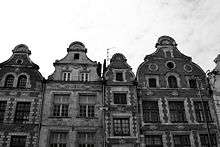Dutch gable

A Dutch gable or Flemish gable is a gable whose sides have a shape made up of one or more curves and has a pediment at the top. The gable may be an entirely decorative projection above a flat section of roof line, or may be the termination of a roof, like a normal gable (the picture of Montacute House, right, shows both types). The preceding is the strict definition, but the term is sometimes used more loosely, though the stepped gable should be distinguished from it. The term "Dutch gable" is also used in America and Australasia to refer to a gablet roof.
The Dutch gable was a notable feature of the Renaissance architecture which spread to northern Europe from the Low Countries, arriving in Britain during the latter part of the 16th century.[1] Later Dutch gables with flowing curves became absorbed into Baroque architecture.
Examples of Dutch-gabled buildings can be found in historic cities across Europe. In Potsdam, Germany, 150 red brick houses featuring steep Dutch gables form part of the city's Dutch Quarter, while in Bruges, Belgium, a wide range of buildings featuring Dutch gables can be found. The Flemish culture also had a strong architectural impact in Arras, northern France. The style also spread beyond Europe, for example Barbados is well known for the Dutch gables on its historic buildings.[2] Dutch settlers in South Africa also brought with them building styles from the Netherlands which included the use of prominent Dutch gables but adjusted to the Western Cape region where the style became known as Cape Dutch architecture.
The formation of Dutch gables requires careful detailing, to weatherproof the junction of the roof with the inner face of the Dutch gable wall with a flashing (weatherproofing).
See also
References
- ↑ The Domestic Architecture of Boston, 1660-1725. Abbott Lowell Cummings Archives of American Art Journal, Vol. 9, No. 4 (1971), pp. 1-16
- ↑ UNESCO.org The Industrial Heritage of Barbados: The Story of Sugar